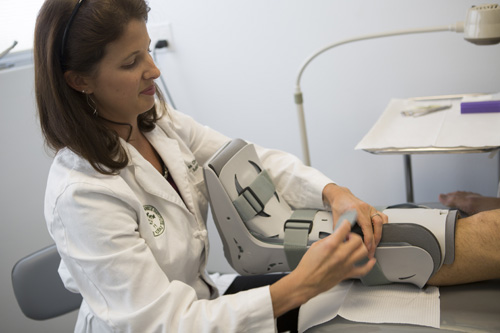(877) 977-1443
Conditions
- Ankle Arthritis
- Ankle Ligament Tear (Sprain)
- Ankle Fractures (Broken Ankle)
- Flat Feet
- Tarsal Coalition
Advanced Treatments
- Regenerative Medicine
- Ankle Arthroscopy
- Total Ankle Replacement
- Ankle Fusion
- Ankle Cartilage Replacement
- Custom Orthotics
- Physical Therapy
- Lifestyle Changes
Education and Articles
Trusted Podiatrists

Flat Feet / Collapsed Arch
Posterior Tibial Tendon Dysfunction
Flat feet is one of those conditions that looks exactly the way it sounds: it is a deformity of the arch of the foot that results in a flat foot. This condition may occur as the result of a genetic defect or because of an injury to the posterior tibial tendon. It can affect one foot or both.
The posterior tibial tendon which is responsible for the degree of arch in your foot is subject to pronation, the movement toward the flat position. Too much pronation leads to flat foot. The condition can cause pain and dysfunction of tendon function with tear, and may even lead to arthritis in the joints. However, not all cases of flat feet lead to other problems and not everyone requires treatment.
Causes of Flat Foot

Most cases of flat foot are genetic. The posterior tibial tendon is commonly overwhelmed by a very strong Achilles tendon, for instance, causing the arch to collapse. In other cases, the tendon can become damaged, weakened, or torn due to trauma or overuse. In cases of flat foot due to injury, the most common contributing factors are increased weight and wearing improper shoes.
Symptoms of Flat Feet
Patients with flat feet often experience fatigue in their feet and ankles after standing for long periods of time. The posterior tibial tendon may be tender or painful. Walking may be difficult due to the pain felt along the arch of the foot. If you experience one or more of these symptoms, you may want to seek treatment for your flat feet. A torn posterior tibial tendon with cause severe arch collapse, arch pain and arch swelling.
Treatment for Flat Feet
The best treatment for flat feet will depend on the severity of the deformity and your individual level of pain. As with many common ailments of the feet and ankles, conservative care is usually the first course of treatment recommended. Custom functional foot orthotics are commonly used to take the strain off your joints and keep your foot aligned in a more corrected position perpendicular to the ground. Orthotics may be paired with special braces in instances of elevated pain.
Ankle Arthritis: Rheumatoid arthritis

Surgery for flat feet can often provide relief for patients whose condition fails to respond to conservative care. There are a number of surgical methods currently used to treat flat feet. Corrections to the damaged posterior tibial tendon, the Achilles tendon, and the bones of the foot are usually used in some combination. In cases of hindfoot/ankle arthritis, joint replacement or fusion of the joints may be needed to keep them locked in the proper position. Repairing or shortening of the posterior tibial tendon can also be helpful; in some cases, and a tendon transplant is needed to establish proper function. Patients with a shortened Achilles tendon may need surgery to lengthen it, allowing the other tendons to function properly.
The Ankle Arthritis Institute is home to the best podiatrists and foot and ankle surgeons in Southern California. Using the latest treatment techniques, they can correct your flat feet and restore optimal function to your feet and ankles.




